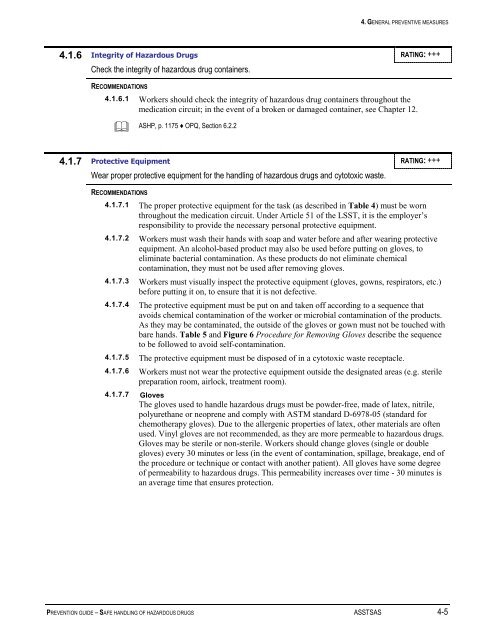Prevention Guide - Safe Handling of Hazardous Drugs - Irsst
Prevention Guide - Safe Handling of Hazardous Drugs - Irsst
Prevention Guide - Safe Handling of Hazardous Drugs - Irsst
You also want an ePaper? Increase the reach of your titles
YUMPU automatically turns print PDFs into web optimized ePapers that Google loves.
4. GENERAL PREVENTIVE MEASURES<br />
4.1.6 Integrity <strong>of</strong> <strong>Hazardous</strong> <strong>Drugs</strong> RATING: +++<br />
Check the integrity <strong>of</strong> hazardous drug containers.<br />
RECOMMENDATIONS<br />
4.1.6.1 Workers should check the integrity <strong>of</strong> hazardous drug containers throughout the<br />
medication circuit; in the event <strong>of</strong> a broken or damaged container, see Chapter 12.<br />
<br />
ASHP, p. 1175 ♦ OPQ, Section 6.2.2<br />
4.1.7 Protective Equipment RATING: +++<br />
Wear proper protective equipment for the handling <strong>of</strong> hazardous drugs and cytotoxic waste.<br />
RECOMMENDATIONS<br />
4.1.7.1 The proper protective equipment for the task (as described in Table 4) must be worn<br />
throughout the medication circuit. Under Article 51 <strong>of</strong> the LSST, it is the employer’s<br />
responsibility to provide the necessary personal protective equipment.<br />
4.1.7.2 Workers must wash their hands with soap and water before and after wearing protective<br />
equipment. An alcohol-based product may also be used before putting on gloves, to<br />
eliminate bacterial contamination. As these products do not eliminate chemical<br />
contamination, they must not be used after removing gloves.<br />
4.1.7.3 Workers must visually inspect the protective equipment (gloves, gowns, respirators, etc.)<br />
before putting it on, to ensure that it is not defective.<br />
4.1.7.4 The protective equipment must be put on and taken <strong>of</strong>f according to a sequence that<br />
avoids chemical contamination <strong>of</strong> the worker or microbial contamination <strong>of</strong> the products.<br />
As they may be contaminated, the outside <strong>of</strong> the gloves or gown must not be touched with<br />
bare hands. Table 5 and Figure 6 Procedure for Removing Gloves describe the sequence<br />
to be followed to avoid self-contamination.<br />
4.1.7.5 The protective equipment must be disposed <strong>of</strong> in a cytotoxic waste receptacle.<br />
4.1.7.6 Workers must not wear the protective equipment outside the designated areas (e.g. sterile<br />
preparation room, airlock, treatment room).<br />
4.1.7.7 Gloves<br />
The gloves used to handle hazardous drugs must be powder-free, made <strong>of</strong> latex, nitrile,<br />
polyurethane or neoprene and comply with ASTM standard D-6978-05 (standard for<br />
chemotherapy gloves). Due to the allergenic properties <strong>of</strong> latex, other materials are <strong>of</strong>ten<br />
used. Vinyl gloves are not recommended, as they are more permeable to hazardous drugs.<br />
Gloves may be sterile or non-sterile. Workers should change gloves (single or double<br />
gloves) every 30 minutes or less (in the event <strong>of</strong> contamination, spillage, breakage, end <strong>of</strong><br />
the procedure or technique or contact with another patient). All gloves have some degree<br />
<strong>of</strong> permeability to hazardous drugs. This permeability increases over time - 30 minutes is<br />
an average time that ensures protection.<br />
PREVENTION GUIDE – SAFE HANDLING OF HAZARDOUS DRUGS ASSTSAS 4-5

















